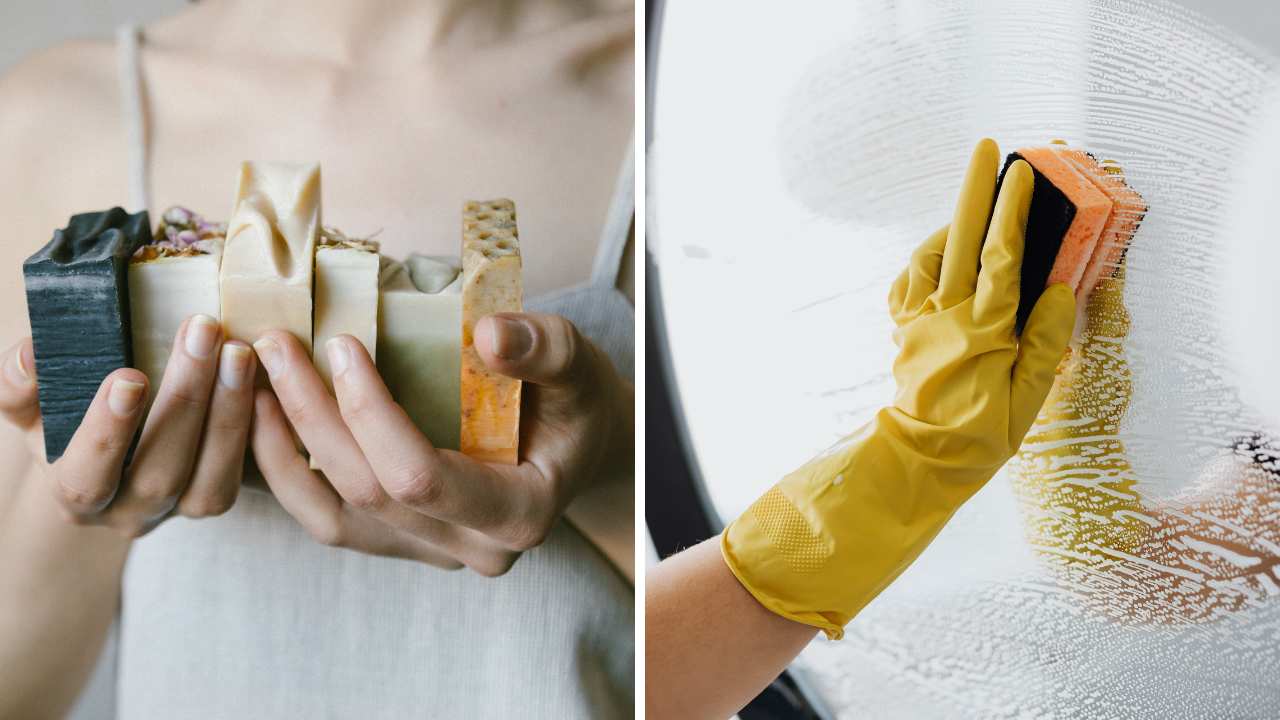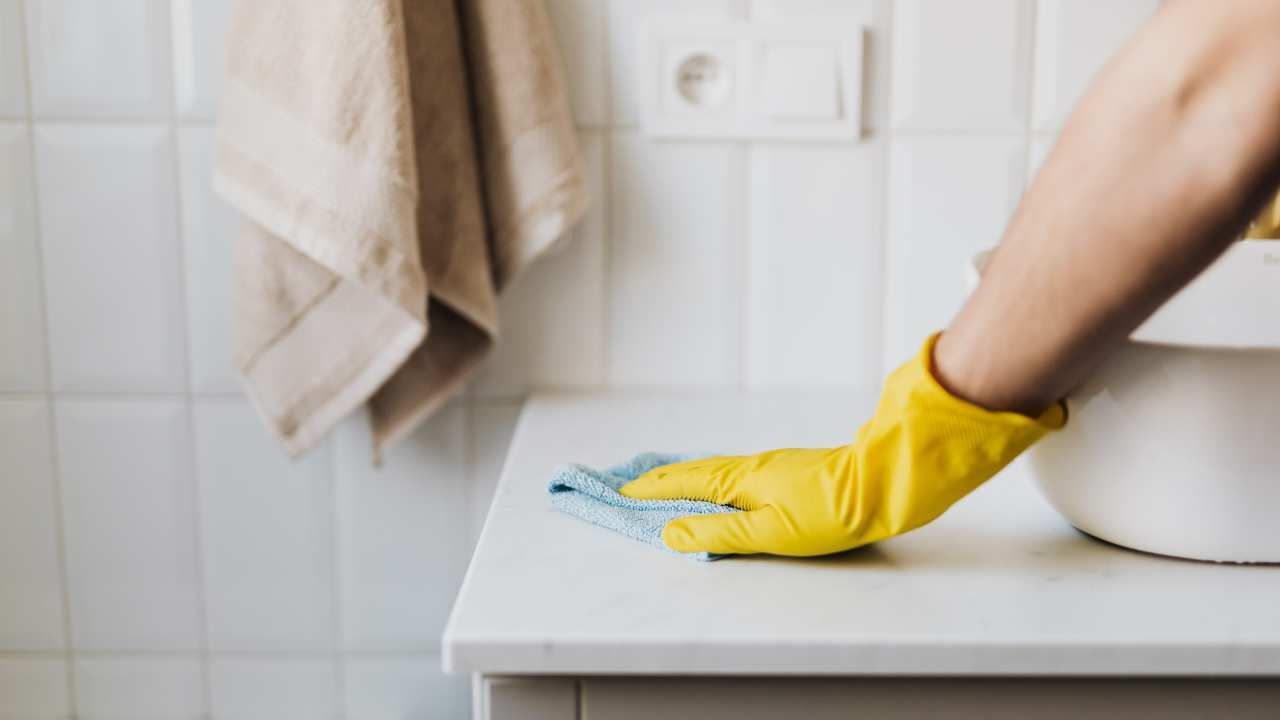How To Clean Soap Scum: A Complete Guide To A Clean Bathroom
Learn the effective and easy steps for cleaning soap scum from your bathroom surfaces! Read this guide to get your bathroom spotless in no time.

Soap scum, an unsightly residue that builds up on bathroom surfaces, can be a frustrating problem to deal with. But fear not, fellow clean freaks, as an expert on cleaning, I'm here to share with you some tips and tricks to tackle soap scum effectively. In this guide, you'll learn about the different causes of soap scum, the best tools and supplies to use, DIY and store-bought cleaners, prevention techniques, and much more. So, let's get started on making your bathroom pristine once again!
If you want more bathroom cleaning hacks check out our article and learn our favorite tricks!
Understanding Soap Scum: What Causes It and Why It's a Problem
Soap scum is the result of a chemical reaction between soap and mineral deposits found in water. Hard water, which contains high levels of calcium and magnesium, makes it harder for soap to dissolve, leaving behind a residue on bathroom surfaces.
Over time, this buildup can become difficult to remove and lead to discoloration and etching on the affected surfaces. Plus, soap scum is a breeding ground for bacteria and fungi, making it a health hazard as well as an eyesore.
Years of soap scum can accumulate in your tub, on glass shower doors, tiled walls, and fixtures. To keep your bathroom surfaces free of soap scum, it's important to clean them regularly and use the best soap scum removers for the job.

The Best Tools and Supplies for Tackling Soap Scum
To start with, a good pair of rubber gloves and safety goggles are essential for protecting your hands and eyes from harsh chemicals. A scrub brush, squeegee, and microfiber cloth are also handy tools for scrubbing, wiping, and drying surfaces.
As for cleaning solutions, vinegar, baking soda, lemon juice, shower gel, and dish detergent are all effective ingredients for homemade cleaners. When it comes to commercial cleaners, look for those specifically formulated to remove soap scum and choose products that are environmentally friendly and free of harmful chemicals.
We think cleaning with vinegar and baking soda is a very effective method for most projects.
DIY Soap Scum Removal Solutions: Homemade Cleaners That Work
For DIY enthusiasts, homemade cleaners are a cost-effective and eco-friendly alternative to store-bought products. One recipe is mixing equal parts of baking soda and dish soap to form a paste, which can be applied to surfaces and left to sit for a few minutes before scrubbing it off.
Another recipe is combining vinegar and water in a spray bottle and spraying it on surfaces, letting it sit for a few minutes, and then wiping it off with a microfiber cloth. Lemon juice can also be used in place of vinegar for a fresh, citrusy scent.

Store-Bought Cleaners: Top Products to Remove Soap Scum Effectively
If you prefer to use store-bought cleaners, some of the top products on the market for removing soap scum include:
- CLR Calcium, Lime & Rust Remover
- Kaboom Shower, Tub & Tile Cleaner
- Scrubbing Bubbles Foaming Bathroom Cleaner
- Method Daily Shower Cleaner
- Seventh Generation Disinfecting Bathroom Cleaner
These products are known for their effectiveness in breaking down soap scum and for leaving surfaces clean and shiny. Be sure to read labels carefully, follow instructions, and test in a small, inconspicuous area before using them on larger surfaces.
Another overlooked item is a bathtub scrubber and with bath scrubbers that run on electricity it makes the job that much easier.
Prevent Soap Scum Buildup: Daily Habits for a Cleaner Bathroom
Prevention is key when it comes to soap scum buildup. By adopting daily cleaning habits, you can minimize the amount of soap scum that accumulates in your bathroom.
Some habits to consider include: wiping down surfaces after each use, using a squeegee to remove excess water from shower walls and doors, rinsing hair and body thoroughly to minimize soap residue, and utilizing a shower caddy to keep bottles and soap off of surfaces.
The Power of Steam: Using a Steam Cleaner for Soap Scum Removal
Steam cleaning is a powerful and eco-friendly method for removing soap scum. By using high-temperature steam, soap scum is loosened and dissolved, making it easier to wipe away. A handheld steam cleaner is a versatile tool that can be used on a wide range of surfaces, including tile, grout, shower doors, and faucets. Plus, the steam acts as a disinfectant, killing bacteria and germs as it cleans.
Steam is a great soap scum remover and can clean surfaces quickly and easily. However, be sure to follow safety instructions when using a steam cleaner and use caution around surfaces that could be damaged by high temperatures.
Deep Cleaning Techniques: How to Remove Stubborn Soap Scum Stains
For really stubborn soap scum stains, you'll need to use some elbow grease and stronger cleaning solutions. One option is using a pumice stone to gently scrub away buildup on surfaces.
Another option is creating a mixture of vinegar and baking soda, applying it to the affected area, letting it sit for a few minutes, and then scrubbing it off with a brush. If none of these methods work, a professional cleaning service may be needed to restore your bathroom to its former glory.
Caring for Different Surfaces: Tips for Removing Soap Scum on Glass, Tile, and More
Different surfaces require different care when it comes to removing soap scum. For glass surfaces, such as shower doors, use a non-abrasive cleaner or a mixture of vinegar and water to avoid scratches.
For tile and grout, a steam cleaner or a mixture of baking soda and vinegar can work wonders. For porcelain surfaces, like sinks and toilets, avoid using abrasive cleaners that can scratch the surface and opt for gentler solutions like dish soap and warm water.
If you want to keep water in your shower so you don't have to clean up after every time check out our tips for keeping water for leaking out of your shower curtain.
A Clean Bathroom Starts with the Right Soap: Choosing Soap That Minimizes Scum
Ultimately, the type of soap you use can influence the amount of soap scum that builds up in your bathroom.
Bar soap, for instance, tends to leave more residue than liquid soap. Likewise, soaps with high levels of glycerin or petroleum-based ingredients can lead to more soap scum.
To minimize soap scum buildup, choose soaps that are low in these ingredients and are formulated for hard water, such as mineral-free soap or soap specifically designed for hard water.
Maintaining a Scum-Free Bathroom: Ongoing Cleaning Tips and Tricks
Maintaining a scum-free bathroom requires ongoing effort. Regular cleaning and upkeep, such as wiping surfaces after use, using a squeegee, and deep cleaning as needed, can minimize the buildup of soap scum. Additionally, using a water softener or a showerhead filter can help reduce the amount of mineral buildup in your water, leading to less soap scum.
Conclusion:
Soap scum may be a common problem in bathrooms, but with the right tools, supplies, and cleaning methods, it can be tackled effectively. From DIY and store-bought cleaners to steam cleaning and prevention techniques, there are plenty of options to choose from when it comes to removing soap scum. Remember to keep safety in mind, test cleaners before use, and follow instructions carefully. By adopting daily cleaning habits and using the right soap, you can maintain a scum-free bathroom and keep your surfaces looking their best.

